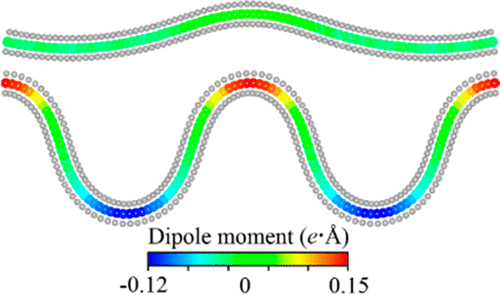当前位置:
X-MOL 学术
›
J. Phys. Chem. Lett.
›
论文详情
Our official English website, www.x-mol.net, welcomes your
feedback! (Note: you will need to create a separate account there.)
Flexoelectricity in Monolayer Transition Metal Dichalcogenides
The Journal of Physical Chemistry Letters ( IF 4.8 ) Pub Date : 2018-11-19 00:00:00 , DOI: 10.1021/acs.jpclett.8b03325 Wenhao Shi 1 , Yufeng Guo 1 , Zhuhua Zhang 1 , Wanlin Guo 1
The Journal of Physical Chemistry Letters ( IF 4.8 ) Pub Date : 2018-11-19 00:00:00 , DOI: 10.1021/acs.jpclett.8b03325 Wenhao Shi 1 , Yufeng Guo 1 , Zhuhua Zhang 1 , Wanlin Guo 1
Affiliation

|
Flexoelectricity, the coupling effect of the strain gradient and charge polarization, is an important route to tune electronic properties of low-dimensional materials. Here our extensive first-principles calculations reveal that structural wrinkling and corrugation will cause significant flexoelectricity in transition metal dichalcogenide (TMD) monolayers. The flexoelectricity is induced by the strain gradients created along the finite thickness of the wrinkled TMD monolayers and becomes more dominant in determining out-of-plane polarizations with decreasing wavelengths of the TMD wrinkles. According to the first-principles calculations and whole structural symmetry, a theoretical model is developed to describe the total out-of-plane polarizations and flexoelectric effect of the wrinkled TMD monolayers. The unveiled flexoelectricity in monolayer TMDs highlights a potential for their application in energy conversion devices.
中文翻译:

单层过渡金属硫属元素化物中的柔性电
柔性电是应变梯度和电荷极化的耦合效应,是微调低维材料电子性能的重要途径。在这里,我们广泛的第一性原理计算表明,结构起皱和起皱会在过渡金属二硫化碳(TMD)单层中引起明显的挠性电。柔性电是由沿起皱的TMD单层的有限厚度产生的应变梯度引起的,并且在确定TMD起皱的波长逐渐减小的面外极化方面变得更加占主导地位。根据第一性原理的计算和整个结构的对称性,建立了一个理论模型来描述起皱的TMD单层的总面外极化和柔电效应。
更新日期:2018-11-19
中文翻译:

单层过渡金属硫属元素化物中的柔性电
柔性电是应变梯度和电荷极化的耦合效应,是微调低维材料电子性能的重要途径。在这里,我们广泛的第一性原理计算表明,结构起皱和起皱会在过渡金属二硫化碳(TMD)单层中引起明显的挠性电。柔性电是由沿起皱的TMD单层的有限厚度产生的应变梯度引起的,并且在确定TMD起皱的波长逐渐减小的面外极化方面变得更加占主导地位。根据第一性原理的计算和整个结构的对称性,建立了一个理论模型来描述起皱的TMD单层的总面外极化和柔电效应。











































 京公网安备 11010802027423号
京公网安备 11010802027423号